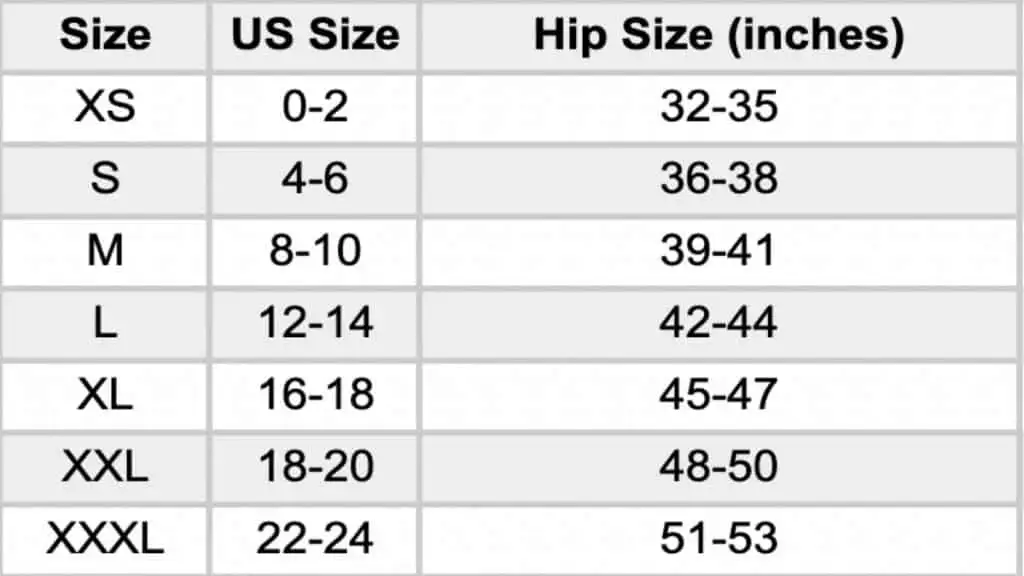Statistically, 40 inch hips are an average hip size for women who live in the US (it’s slightly less for men). But is this really a good thing?
It’s clear that people are getting larger, and that certainly includes the hips. But as you’re about to learn, you need to factor in your bone structure, body composition, and waist when deciding whether a given hip measurement is big or not.
With this in mind, the following article will discuss whether or not having 40″ hips—the average glute size—is desirable for men and women in terms of both health and aesthetics.
See How Your Hips Stack Up:
- 39 inch butt
- 41 inch butt
- 42 inch butt
- 43 inch butt
- 44 inch butt
- 45 inch butt
- 46 inch butt
- 47 inch butt
- 48 inch butt
- 49 inch butt
Are 40 inch hips big for a woman?

Are 40 inch hips big for a woman? Based on the available anthropometric data, 40 inch hips are an average size for a woman. However, many people would still say that 40″ hips are large for a female because, in terms of circumference, 40 inches really is a sizable measurement.
As for how big a 40 inch hip measurement will actually look, this mainly depends on the size of your waist and your body composition. Let me explain.
Say you have a tiny waist and 40 inch hips. In this case, your hips will likely look huge due to the massive size difference between your waist and hips. Or, to put it another way, you’ll have a very low waist-to-hip ratio (WHR).
Not only can your WHR help you understand how your body looks, but research shows that, in many cases, it’s also a better predictor of cardiovascular health than BMI. [1]
As for your body composition, having 40 inch glutes that are muscular will likely make your hips look more prominent than having 40 inch hips that mainly consist of fat. Of course, most people who have 40 in hips have a mixture of gluteal muscle mass and fat tissue.
Finally, your bone structure and, in particular, your height greatly affect how your 40″ hips look. So, to illustrate, if a short woman and a tall woman both have 40 inch hips, the short woman’s hips will look larger because her glute mass is more bunched up (over a smaller surface area) rather than stretched out over a longer body.
Are 40 inch hips big for a man?

Are 40 inch hips big for a man? Yes, based on the data, 40 inch hips are one inch larger than average for an adult male. Still, many people would say that 40″ hips are very big for a man seeing as men tend to have slimmer hips than women.
If a man has 40 in hips, then he either has well-developed glutes, a relatively high body fat level, or a combination of both.
Since the glutes are such a large and powerful muscle, they really do have a lot of potential to accumulate new muscle tissue. So your glutes can easily grow by a few inches if you increase your squat, deadlift, and hip thrust strength.
Additionally, any large muscle naturally has a lot of capacity for fat storage due to its big surface area. In addition to individual fat storage genetics, the sheer size of the glutes is one reason why many men and women tend to store a considerable amount of fat around their glutes and hips.
What size are 40 inch hips?

What size are 40 inch hips? The exact size for 40 inch hips heavily depends on the brand of clothing and the garment type. Additionally, you need to factor in the size of your waist when buying clothing. Still, in many cases, 40″ hips are equal to a size medium in women’s clothing, which works out at a US size 8-10.
Is it good to have a 40 inch butt?

So, is it actually good to have a 40 inch butt? Well, it depends. Is your 40 inch booty causing you to be overweight or obese? If not, then it’s highly unlikely that there’s anything wrong with—in and of itself—having a 40 inch butt.
Now, if you don’t currently have a 40 inch booty but would like to build one—or if you want to make your 40 inch glutes even bigger—then the following advice will be helpful.
For years in the glute-building world, squats—and literally just squats—were the default recommendation for building a bigger butt. However, in more recent times, research has shown that, while squats are still a great glute exercise, hip thrusts lead to higher levels of glute activation. [2]
This is why I recommend making the hip thrust your primary exercise (i.e., do it before squats). After hip thrusts—which really contract your glutes—train your glutes in a stretched position with some kind of squat, split squat, step up, or reverse lunge.
Then, make sure to do some kind of hip abduction exercise for the gluteus medius. Yes, this is a small muscle, but it’s definitely not an area that you want to skip over.
That’s the basics of building your glutes. You can, of course, slowly increase your body weight as well by eating more protein and a calorie surplus diet—which will definitely increase your circumference measurement.
Alternatively, you can very likely expand your 40 inch hips by simply eating at maintenance but changing your macros so that you get more protein than you otherwise would from a standard diet.
Conclusion: Is having 40″ hips a good thing?

As mentioned, providing that your 40 inch hips aren’t a sign that you have some kind of problem, it’s absolutely fine to have a 40 inch hip size. And if that doesn’t pacify your concerns, just remember that the average man and woman have hips that measure roughly 40 inches.
Of course, since the average person is overweight and very likely unhealthy, you probably don’t want to mimic that kind of body type, despite it being normal. Still, you can definitely have 40 in hips while having a healthy body, especially if you build your glutes with resistance training.
Finally, as long as you’re healthy, go ahead and embrace your body. Sure, you can also make your hips bigger or smaller by training your glutes or losing weight, but you might as well love what you currently have.
References
- Elsayed, E. F., Tighiouart, H., Weiner, D. E., Griffith, J., Salem, D., Levey, A. S., & Sarnak, M. J. (2008). Waist-to-hip ratio and body mass index as risk factors for cardiovascular events in CKD. American journal of kidney diseases : the official journal of the National Kidney Foundation, 52(1), 49–57. https://doi.org/10.1053/j.ajkd.2008.04.002
- Contreras, B., Vigotsky, A. D., Schoenfeld, B. J., Beardsley, C., & Cronin, J. (2015). A Comparison of Gluteus Maximus, Biceps Femoris, and Vastus Lateralis Electromyographic Activity in the Back Squat and Barbell Hip Thrust Exercises. Journal of Applied Biomechanics, 31(6), 452–458. https://doi.org/10.1123/jab.2014-0301

